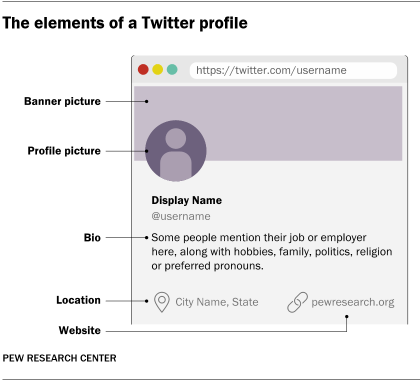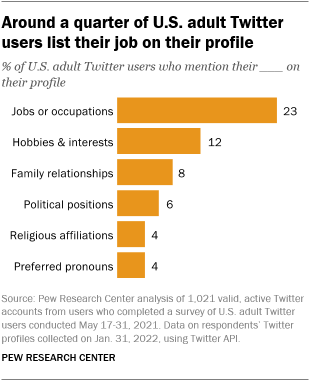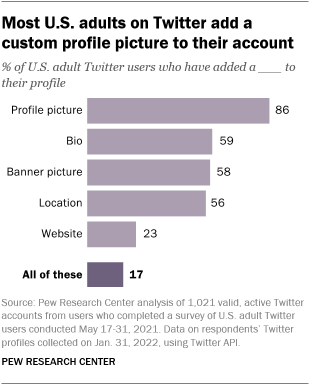Political content can make up a rather modest share of what regular users write-up on Twitter. And only a tiny share of adult Twitter customers in the United States – largely older Us residents, Democrats and those who tweet the most – include things like political language in their profiles on the internet site. In its place, it is considerably extra widespread for these users to mention issues like their profession or their hobbies, in accordance to a new Pew Investigate Middle investigation.

When end users generate a Twitter account, they are prompted to give diverse pieces of facts that are displayed on their profile. They are expected to supply a exhibit title to initiate a new account, but other features – this kind of as their profile image, banner image, bio, site and internet site – are remaining to the discretion of the user. All of these factors can be modified at any time above the existence of the account.
Approximately a few-quarters (73%) of U.S. adult Twitter end users contain at the very least some identifiable text in their profile, but 27% involve no textual content in any respect aside from the essential display and username fields, according to the Center’s investigation.
The Twitter profile is an integral part of users’ encounter on the system. It serves as an option for people to craft a general public identification and shape how they are perceived by other buyers. This investigation examines how U.S. older people on Twitter interact with the platform’s operation and the types of information and facts they typically share on their profile.
This evaluation is dependent on the Twitter profiles of 1,021 survey respondents who volunteered a Twitter deal with (their exceptional username preceded by an “@” sign) for analysis reasons and whose handle was valid and energetic as of Jan. 31, 2022. Every person analyzed in this analyze is a member of the Center’s American Developments Panel (ATP) – an on-line survey panel that is recruited through national, random sampling of residential addresses – who indicated that they use Twitter. Scientists from the Centre manually examined these profiles and categorised their information to identify if they outlined a range of vital themes and subjects. The last identified matters provided references to each respondent’s position or occupation hobbies and passions spouse and children interactions political affiliations religious beliefs and chosen pronouns.
More about the style of the study in which these handles were being originally gathered can be found in the 2021 report’s methodology. This coding methodology presents much more data about how the Centre categorised the distinctive factors of people’s profiles.
Customers who do select to customize their profile particulars mention a assortment of matters and issues. Most notably, around a quarter of U.S. grown ups on Twitter (23%) point out their position or occupation on their profile. And a person-third of these end users – the equivalent of 8% of all U.S. grownup Twitter end users – immediately point out the identify of their employer or affiliated group.

Considerably fewer people – all over just one-in-10 – mention subject areas these kinds of as their hobbies or other passions, or their families or familial roles. Meanwhile, just 6% involve explicitly political language that implies a situation or guidance for a political celebration, ideology, determine, firm or key political motion. And just 4% every mention their spiritual beliefs or favored pronouns (this kind of as “she/her” or “they/them”).
Democrats and Republicans are likewise likely to point out their occupations or loved ones interactions in their Twitter profiles. But while it is fairly scarce for members of both bash to contain explicitly political language in their profiles, Democrats and Democratic-leaning independents are a lot more likely than Republicans and Republican leaners to do so (7% vs. 2%). Likewise, 6% of Democratic buyers – but not a solitary Republican in the Center’s consultant sample – pointed out their most popular pronouns in their profile.
Together with Democrats, more mature Twitter consumers are more very likely to mention their political leanings on their profile: 12% of end users ages 50 and older do so, in comparison with just 4% of consumers ages 18 to 49. In a 2019 assessment, the Middle discovered that older buyers produced an outsize share of political tweets. Older Individuals are also additional most likely than young consumers to mention their spouse and children relationships (16% vs. 6%).
The existence of political language in users’ profiles also may differ by how regularly U.S. grown ups tweet. Amongst users who averaged 20 or extra tweets per month above the lifetime of their account, 13% mention politics in their profiles, in comparison with just 2% between significantly less prolific tweeters. These conclusions align with the success of a 2021 Centre study, which identified that the most repeated tweeters are additional politically inclined than much less lively tweeters.
Buyers in the best 25% of followers are also a lot more likely than all those with less followers to include political language in their profiles: 17% do so, compared with 2% of those people with less followers. Together with politics, this team is around two times as likely as these with fewer followers to listing their profession in their Twitter profile (37% vs. 19%) and around four periods as probable to specifically point out the identify of their business (18% vs. 4%).
Most grownup Twitter people in U.S. incorporate a photograph, but number of fill out their profiles fully

When it comes to other features of their profiles, most U.S. adult Twitter customers (86%) include a profile image other than the default nameless avatar assigned to new accounts. And practically 6-in-ten (58%) increase a banner image.
The style and design of this review can make it difficult to know no matter if a profile picture is made up of an precise graphic of the account holder. But among those people who include a photograph someplace on their profile, 69% use an picture that is not a meme, stock photograph or public area picture, and that exhibits another person with discernible facial capabilities who is neither a general public determine nor fictional character.
Past pics, much more than 50 % of U.S. adult Twitter consumers customize the bio (59%) and area (56%) fields of their profile, while all over a quarter (23%) incorporate a website URL. Some 51% of the profiles mention a true geographic location within just the United States.
General, 17% of U.S. grownup Twitter buyers include all 5 of these components: a profile photo, a banner picture, a bio, a area and a internet site. The usual (median) U.S. adult on Twitter fills out three of these five probable profile aspects.




More Stories
The English PROPHECY US DESTINY: The famous medium predicted the outcome of the match Serbia
Kyiv’s Mayor Warns Residents To Prepare For A Total Absence Of Electricity, Water, Drainage And Heat
Virginia Criminal Lawyer: Your Guide to Legal Representation in Virginia